Research Work/Project Work - Medication Summary
Added on 2022-12-15
41 Pages8765 Words488 Views
Assessment Details
Qualification Code: Title HLT54115 – Diploma of Nursing
Assessment Type Assessment 2 Research Work/Project work
Due Date
Location
Term-Year
Unit of Competency
Unit
Code/Title
HLTENN007 Administer and monitor medicines and
intravenous therapy
Student Details
Student Name Student ID
Feedback to Student
RESULTS (Please Circle) SATISFACTORY NOT SATISFACTORY
Assessor Details
Assessors Name
Assessor Signature
Date
Australian Harbour International College, 114-120 Castlereagh Street, Sydney NSW 2000, Australia
|RTO NO: 41338 | CRICOS Provider Code: 03449J
Filename: HLTENN007 Administer and monitor medicines
and intravenous therapy
Version 2.0/ March 2018 Review Date: March
2019
Page 1 of 41
Qualification Code: Title HLT54115 – Diploma of Nursing
Assessment Type Assessment 2 Research Work/Project work
Due Date
Location
Term-Year
Unit of Competency
Unit
Code/Title
HLTENN007 Administer and monitor medicines and
intravenous therapy
Student Details
Student Name Student ID
Feedback to Student
RESULTS (Please Circle) SATISFACTORY NOT SATISFACTORY
Assessor Details
Assessors Name
Assessor Signature
Date
Australian Harbour International College, 114-120 Castlereagh Street, Sydney NSW 2000, Australia
|RTO NO: 41338 | CRICOS Provider Code: 03449J
Filename: HLTENN007 Administer and monitor medicines
and intravenous therapy
Version 2.0/ March 2018 Review Date: March
2019
Page 1 of 41
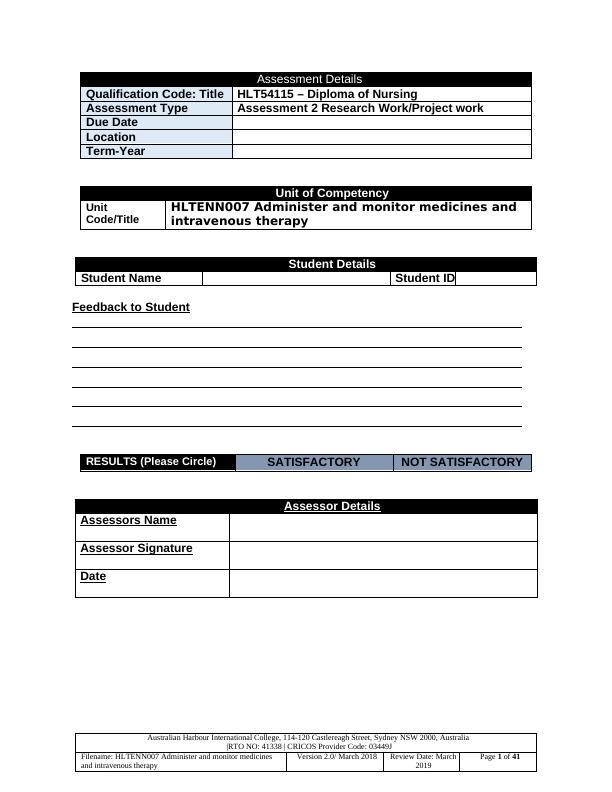
Assessment 2 -Research Work/Project Work
Instructions to the students
Answer the questions below in the spaces provided
Ensure all references are documented under each individual
question.
Answers are to be written in ink
Group Work
Research Project 1
Assessor will divide the large group into 4 smaller groups Each group will present back to the
larger group with a 5-minute presentation (can be written, oral, slide presentation) on the
information for each medication. The table of medications must be completed by all students
with the research information presented by each group. Please list group members names
GROUP
1
Lasix and Liptor
GROUP
2
Metformin and Warfrin
GROUP
3
Cephalexin and Zoloft
GROUP
4
Morphine and Salbutamol
Research the following medications listed in the table below and complete the pharmacological
information required. (Brief summary for the entire medication information Min 150 words)
GROUP 1
Medication: Furosemide
(Lasix)
Brief summary
pharmacodynamics Furosemide, a sulfonamide-type loop diuretic structurally related
to bumetanide, is used to manage hypertension and edema
associated with congestive heart failure, cirrhosis, and renal
disease, including the nephrotic syndrome. ("Furosemide -
DrugBank", 2019)
pharmacokinetics Absorption - 60–67% absorbed after oral administration (↓ in
acute HF and in renal failure); also absorbed from IM sites.
("furosemide | Davis’s Drug Guide", 2019)
Distribution- Crosses placenta, enters breast milk. ("furosemide |
Australian Harbour International College, 114-120 Castlereagh Street, Sydney NSW 2000, Australia
|RTO NO: 41338 | CRICOS Provider Code: 03449J
Filename: HLTENN007 Administer and monitor medicines
and intravenous therapy
Version 2.0/ March 2018 Review Date: March
2019
Page 2 of 41
Instructions to the students
Answer the questions below in the spaces provided
Ensure all references are documented under each individual
question.
Answers are to be written in ink
Group Work
Research Project 1
Assessor will divide the large group into 4 smaller groups Each group will present back to the
larger group with a 5-minute presentation (can be written, oral, slide presentation) on the
information for each medication. The table of medications must be completed by all students
with the research information presented by each group. Please list group members names
GROUP
1
Lasix and Liptor
GROUP
2
Metformin and Warfrin
GROUP
3
Cephalexin and Zoloft
GROUP
4
Morphine and Salbutamol
Research the following medications listed in the table below and complete the pharmacological
information required. (Brief summary for the entire medication information Min 150 words)
GROUP 1
Medication: Furosemide
(Lasix)
Brief summary
pharmacodynamics Furosemide, a sulfonamide-type loop diuretic structurally related
to bumetanide, is used to manage hypertension and edema
associated with congestive heart failure, cirrhosis, and renal
disease, including the nephrotic syndrome. ("Furosemide -
DrugBank", 2019)
pharmacokinetics Absorption - 60–67% absorbed after oral administration (↓ in
acute HF and in renal failure); also absorbed from IM sites.
("furosemide | Davis’s Drug Guide", 2019)
Distribution- Crosses placenta, enters breast milk. ("furosemide |
Australian Harbour International College, 114-120 Castlereagh Street, Sydney NSW 2000, Australia
|RTO NO: 41338 | CRICOS Provider Code: 03449J
Filename: HLTENN007 Administer and monitor medicines
and intravenous therapy
Version 2.0/ March 2018 Review Date: March
2019
Page 2 of 41

Davis’s Drug Guide", 2019)
Metabolism- Minimally metabolized by liver, some nonhepatic
metabolism ("furosemide | Davis’s Drug Guide", 2019)
Excretion- Furosemide is excreted in urine. Significantly more
furosemide is excreted in urine following the I.V. injection than
after the tablet or oral solution. ("Furosemide - DrugBank",
2019)
adverse reactions blurred vison
hearing loss, hearing changes such as ringing in the ears.
hyperglycemia
paresthesia
rapid weight loss
jaundice (yellowing of skin and eyes). (furosemide & Lasix,
2019)
stomach/abdominal pain
allergic reaction like rash, itching, swelling
trouble breathing(Cold et al., 2019)
contraindications and
Precautions
Contraindicated in:
Hypersensitivity;
Cross-sensitivity with thiazides and sulfonamides may
occur;
Hepatic coma or anuria;
Some liquid products may contain alcohol, avoid in
patients with alcohol intolerance("furosemide | Davis’s
Drug Guide", 2019)
Precautions :
Severe liver disease (may precipitate hepatic coma;
concurrent use with potassium-sparing diuretics may be
necessary);
Using this medicine while being pregnant may cause the
unborn baby to be bigger than normal. The doctor should
be informed in such a case.
Electrolyte depletion;
Diabetes mellitus;
Hypoproteinemia (↑ risk of ototoxicity);
Severe renal impairment (↑ risk of ototoxicity);
("furosemide | Davis’s Drug Guide", 2019)
Kidney problems
side effects increased urination
Australian Harbour International College, 114-120 Castlereagh Street, Sydney NSW 2000, Australia
|RTO NO: 41338 | CRICOS Provider Code: 03449J
Filename: HLTENN007 Administer and monitor medicines
and intravenous therapy
Version 2.0/ March 2018 Review Date: March
2019
Page 3 of 41
Metabolism- Minimally metabolized by liver, some nonhepatic
metabolism ("furosemide | Davis’s Drug Guide", 2019)
Excretion- Furosemide is excreted in urine. Significantly more
furosemide is excreted in urine following the I.V. injection than
after the tablet or oral solution. ("Furosemide - DrugBank",
2019)
adverse reactions blurred vison
hearing loss, hearing changes such as ringing in the ears.
hyperglycemia
paresthesia
rapid weight loss
jaundice (yellowing of skin and eyes). (furosemide & Lasix,
2019)
stomach/abdominal pain
allergic reaction like rash, itching, swelling
trouble breathing(Cold et al., 2019)
contraindications and
Precautions
Contraindicated in:
Hypersensitivity;
Cross-sensitivity with thiazides and sulfonamides may
occur;
Hepatic coma or anuria;
Some liquid products may contain alcohol, avoid in
patients with alcohol intolerance("furosemide | Davis’s
Drug Guide", 2019)
Precautions :
Severe liver disease (may precipitate hepatic coma;
concurrent use with potassium-sparing diuretics may be
necessary);
Using this medicine while being pregnant may cause the
unborn baby to be bigger than normal. The doctor should
be informed in such a case.
Electrolyte depletion;
Diabetes mellitus;
Hypoproteinemia (↑ risk of ototoxicity);
Severe renal impairment (↑ risk of ototoxicity);
("furosemide | Davis’s Drug Guide", 2019)
Kidney problems
side effects increased urination
Australian Harbour International College, 114-120 Castlereagh Street, Sydney NSW 2000, Australia
|RTO NO: 41338 | CRICOS Provider Code: 03449J
Filename: HLTENN007 Administer and monitor medicines
and intravenous therapy
Version 2.0/ March 2018 Review Date: March
2019
Page 3 of 41
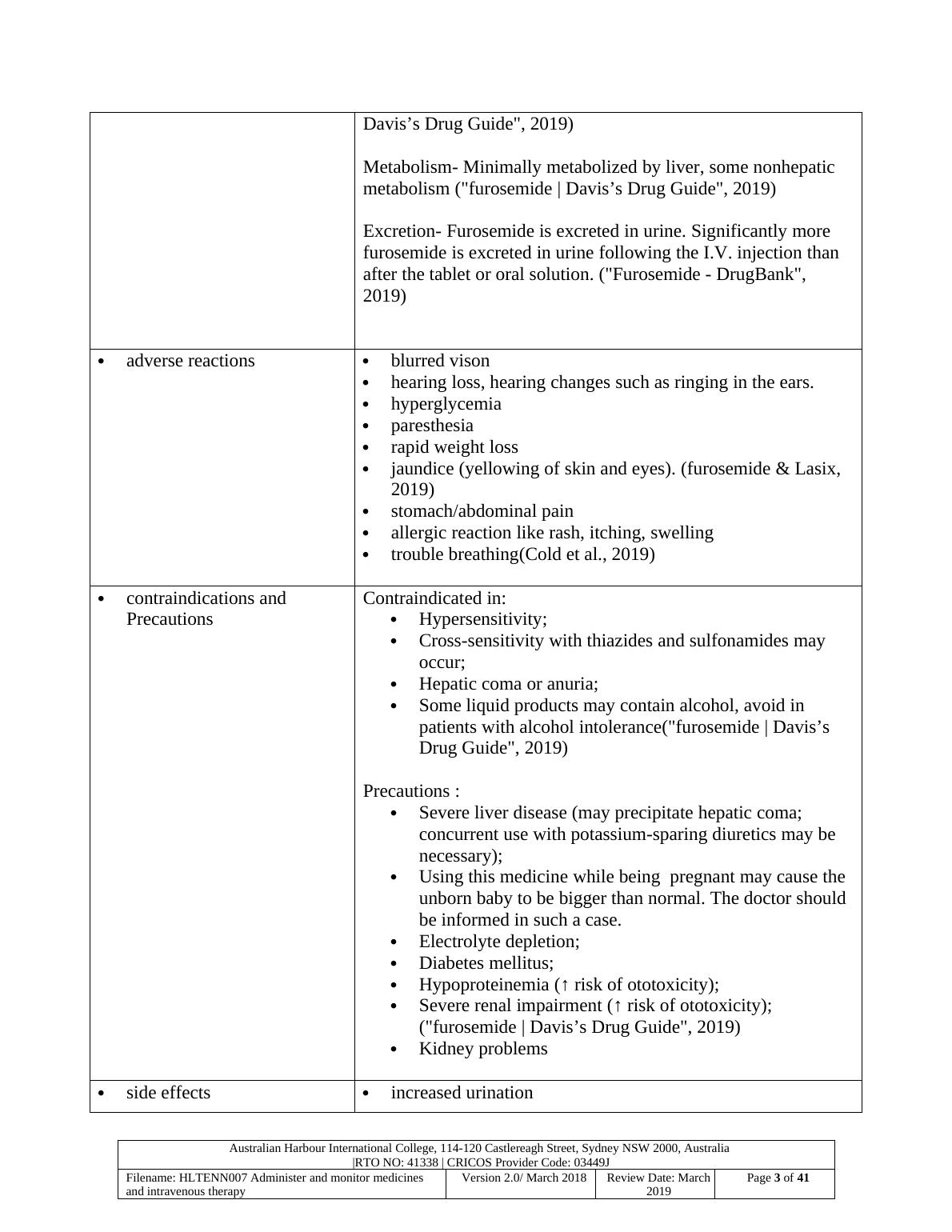
thirst
headache
muscle cramps
itching or rash
weakness
dizziness
spinning sensation
diarrhea
stomach pain
constipation (furosemide & Lasix, 2019)
fever
vomiting
loss of appetite
Medication: Atorvastatin
(Lipitor)
Brief summary
pharmacodynamics Atorvastatin is used to treat high cholesterol and prevent from
the risk of stroke, heart disease. It helps to clear low density
lipoprotein cholesterol from the body by limiting ability to
produce new LDL cholesterol so live is the primary site of
action. (Lipitor ( atorvastatin Calcium tablets,2019)
pharmacokinetics
Absorption: It is continuously absorbed after oral intake
maximum plasma concentrations occur within 1 to 2 hours. The
low systemic availability is attributed to presystemic clearance in
gastrointestinal mucosa and/or hepatic first-pass metabolism.
Although food decreases the rate and extent of drug absorption
by approximately 25% and 9%, respectively .Plasma LIPITOR
concentrations are lower (approximately 30% for Cmax and
AUC) following evening drug administration compared with
morning. However, LDL-C reduction is the same regardless of
the time of day of drug administration. (Lipitor ( atorvastatin
Calcium tablets,2019)
Disturbution:The volume of distribution of atorvastatin is 381
litre. It is 98>% bound to plasma protein. The plasma ratio of
0.25 denotes poor medication penetration into the red blood cell.
(Lipitor ( atorvastatin Calcium tablets,2019)
Metabolism: It is metabolized in the bile followed by the liver
and extra hepatically metabolism. The metabolism is performed
mainly by the activity of cytochrome P450 3A4 and its metabolic
pathway produces mainly active ortho- and para-hydroxylated
metabolites2 as well as various beta-oxidation minor
Australian Harbour International College, 114-120 Castlereagh Street, Sydney NSW 2000, Australia
|RTO NO: 41338 | CRICOS Provider Code: 03449J
Filename: HLTENN007 Administer and monitor medicines
and intravenous therapy
Version 2.0/ March 2018 Review Date: March
2019
Page 4 of 41
headache
muscle cramps
itching or rash
weakness
dizziness
spinning sensation
diarrhea
stomach pain
constipation (furosemide & Lasix, 2019)
fever
vomiting
loss of appetite
Medication: Atorvastatin
(Lipitor)
Brief summary
pharmacodynamics Atorvastatin is used to treat high cholesterol and prevent from
the risk of stroke, heart disease. It helps to clear low density
lipoprotein cholesterol from the body by limiting ability to
produce new LDL cholesterol so live is the primary site of
action. (Lipitor ( atorvastatin Calcium tablets,2019)
pharmacokinetics
Absorption: It is continuously absorbed after oral intake
maximum plasma concentrations occur within 1 to 2 hours. The
low systemic availability is attributed to presystemic clearance in
gastrointestinal mucosa and/or hepatic first-pass metabolism.
Although food decreases the rate and extent of drug absorption
by approximately 25% and 9%, respectively .Plasma LIPITOR
concentrations are lower (approximately 30% for Cmax and
AUC) following evening drug administration compared with
morning. However, LDL-C reduction is the same regardless of
the time of day of drug administration. (Lipitor ( atorvastatin
Calcium tablets,2019)
Disturbution:The volume of distribution of atorvastatin is 381
litre. It is 98>% bound to plasma protein. The plasma ratio of
0.25 denotes poor medication penetration into the red blood cell.
(Lipitor ( atorvastatin Calcium tablets,2019)
Metabolism: It is metabolized in the bile followed by the liver
and extra hepatically metabolism. The metabolism is performed
mainly by the activity of cytochrome P450 3A4 and its metabolic
pathway produces mainly active ortho- and para-hydroxylated
metabolites2 as well as various beta-oxidation minor
Australian Harbour International College, 114-120 Castlereagh Street, Sydney NSW 2000, Australia
|RTO NO: 41338 | CRICOS Provider Code: 03449J
Filename: HLTENN007 Administer and monitor medicines
and intravenous therapy
Version 2.0/ March 2018 Review Date: March
2019
Page 4 of 41
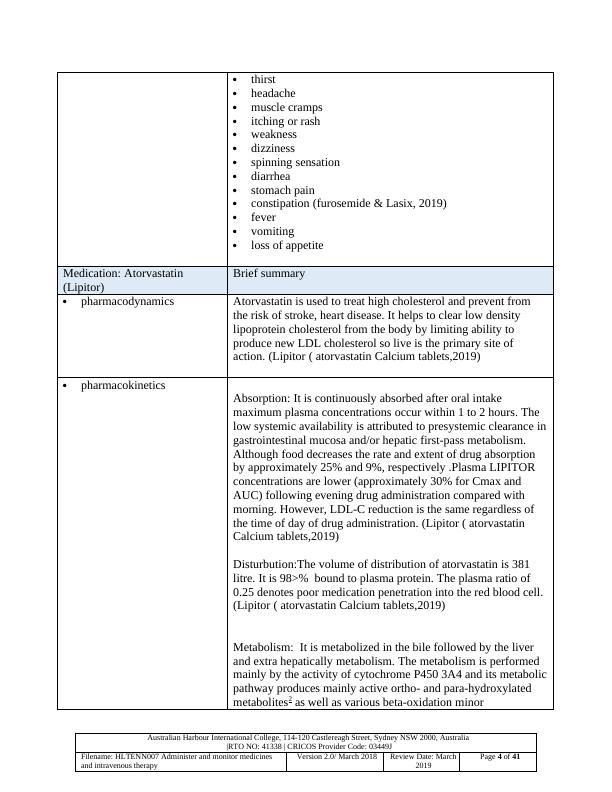
metabolites.3 The metabolism of atorvastatin is ruled by reactions
of oxidation, lactonization and glucuronidation. The ortho- and
para-hydroxylated metabolites of atorvastatin account for about
70% of the activity against HMG-CoA reductase ("Atorvastatin -
DrugBank", 2019)
Route of elimination: It is eliminated primarily in bile following
hepatic metabolism with less than 2% of it recovered in the
urine. but the medicine doesn’t go through enter hepatic
recirculation. It has an approximate elimination half-life of 14
hours. Noteworthy, the HMG-CoA reductase inhibitory activity
appears to have a half-life of 20–30 hours, which is thought to be
due to the active metabolites.
("Atorvastatin - DrugBank", 2019)
adverse reactions The adverse reactions of atorvastatin are as follows:
Kidney failure
Liver problems like jaundice
Lung Tissue Problems
Muscle Inflammation
Neck Stiffness
Pancreatitis
Rupture of tendon
Depression
Loss of memory
Life threading Allergic Reaction
Hepatitis
(Lipitor adverse effects by likelihood and severity,2019)
contraindications &
precautions
Contra indication for atorvastatin are as follow:
Pregnancy
A person suffering from liver disease.
Untreated decreased level of thyroid hormone
Brain hemorrhage
Loss of memory
Breast feeding mother
Allergies
Recent operation
(Cold et al., 2019)
Precautions
Use birth control methods to prevent pregnancy because
this medication can cause birth defects.
Australian Harbour International College, 114-120 Castlereagh Street, Sydney NSW 2000, Australia
|RTO NO: 41338 | CRICOS Provider Code: 03449J
Filename: HLTENN007 Administer and monitor medicines
and intravenous therapy
Version 2.0/ March 2018 Review Date: March
2019
Page 5 of 41
of oxidation, lactonization and glucuronidation. The ortho- and
para-hydroxylated metabolites of atorvastatin account for about
70% of the activity against HMG-CoA reductase ("Atorvastatin -
DrugBank", 2019)
Route of elimination: It is eliminated primarily in bile following
hepatic metabolism with less than 2% of it recovered in the
urine. but the medicine doesn’t go through enter hepatic
recirculation. It has an approximate elimination half-life of 14
hours. Noteworthy, the HMG-CoA reductase inhibitory activity
appears to have a half-life of 20–30 hours, which is thought to be
due to the active metabolites.
("Atorvastatin - DrugBank", 2019)
adverse reactions The adverse reactions of atorvastatin are as follows:
Kidney failure
Liver problems like jaundice
Lung Tissue Problems
Muscle Inflammation
Neck Stiffness
Pancreatitis
Rupture of tendon
Depression
Loss of memory
Life threading Allergic Reaction
Hepatitis
(Lipitor adverse effects by likelihood and severity,2019)
contraindications &
precautions
Contra indication for atorvastatin are as follow:
Pregnancy
A person suffering from liver disease.
Untreated decreased level of thyroid hormone
Brain hemorrhage
Loss of memory
Breast feeding mother
Allergies
Recent operation
(Cold et al., 2019)
Precautions
Use birth control methods to prevent pregnancy because
this medication can cause birth defects.
Australian Harbour International College, 114-120 Castlereagh Street, Sydney NSW 2000, Australia
|RTO NO: 41338 | CRICOS Provider Code: 03449J
Filename: HLTENN007 Administer and monitor medicines
and intravenous therapy
Version 2.0/ March 2018 Review Date: March
2019
Page 5 of 41
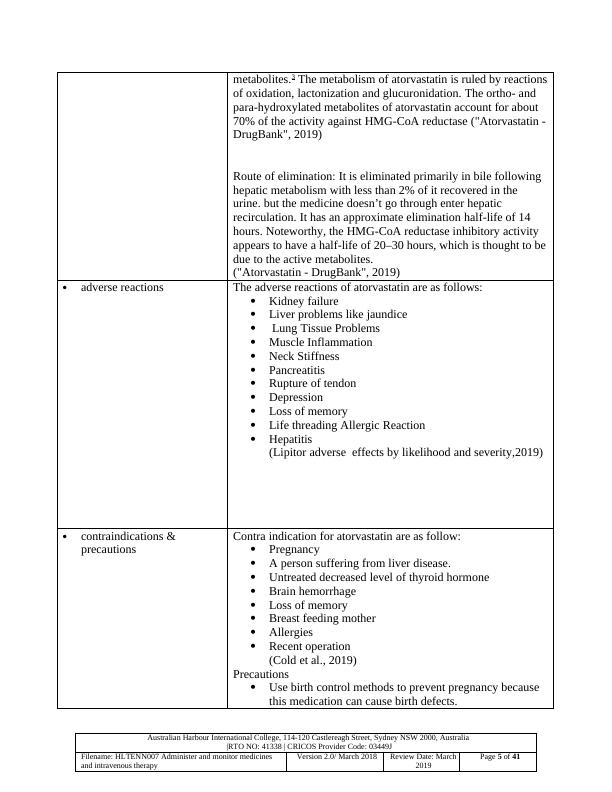
Always inform doctor about the medication you are
having and health problems like diabetes, liver disease,
kidney disease.
Don’t breasts feed the child if you are taking this
medication.
Avoid eating high cholesterol, foods as it taking
medication may not be effective.
Don’t take alcohol as it can increase triglyceride levels
and elevate the risk of live damage.
("Lipitor (atorvastatin) Side Effects, Interactions, Uses
& Drug Imprint", 2019)
side effects The side effect are as follows:
Joint pain
stuffy nose, sore throat
diarrhea
pain in your arms or legs
Dizziness
Rash
Mild Muscle pain
Headache
Gas
Nausea
(calcium & Lipitor, 2019)
GROUP 2
Medication: Metformin
(Glucophage)
Brief summary
pharmacodynamics As body needs insulin hormone to regulate the blood glucose
levels, people with type 2 diabetes has decreased sensitivity to
insulin which causes elevation in blood glucose as pancreas can
no longer compensate. Metformin decreases production of
glucose in the liver (gluconeogenesis), it reduces absorption of
glucose from intestine and also enhances insulin sensitivity by
elevating both peripheral glucose intake and utilization. This
process helps to decrease the blood glucose, manages type 2
diabetes and has positive effects on glycemic control.
("Metformin – Drug Bank", 2019)
pharmacokinetics
After ingestion, when metformin reaches to the liver cells, it
Australian Harbour International College, 114-120 Castlereagh Street, Sydney NSW 2000, Australia
|RTO NO: 41338 | CRICOS Provider Code: 03449J
Filename: HLTENN007 Administer and monitor medicines
and intravenous therapy
Version 2.0/ March 2018 Review Date: March
2019
Page 6 of 41
having and health problems like diabetes, liver disease,
kidney disease.
Don’t breasts feed the child if you are taking this
medication.
Avoid eating high cholesterol, foods as it taking
medication may not be effective.
Don’t take alcohol as it can increase triglyceride levels
and elevate the risk of live damage.
("Lipitor (atorvastatin) Side Effects, Interactions, Uses
& Drug Imprint", 2019)
side effects The side effect are as follows:
Joint pain
stuffy nose, sore throat
diarrhea
pain in your arms or legs
Dizziness
Rash
Mild Muscle pain
Headache
Gas
Nausea
(calcium & Lipitor, 2019)
GROUP 2
Medication: Metformin
(Glucophage)
Brief summary
pharmacodynamics As body needs insulin hormone to regulate the blood glucose
levels, people with type 2 diabetes has decreased sensitivity to
insulin which causes elevation in blood glucose as pancreas can
no longer compensate. Metformin decreases production of
glucose in the liver (gluconeogenesis), it reduces absorption of
glucose from intestine and also enhances insulin sensitivity by
elevating both peripheral glucose intake and utilization. This
process helps to decrease the blood glucose, manages type 2
diabetes and has positive effects on glycemic control.
("Metformin – Drug Bank", 2019)
pharmacokinetics
After ingestion, when metformin reaches to the liver cells, it
Australian Harbour International College, 114-120 Castlereagh Street, Sydney NSW 2000, Australia
|RTO NO: 41338 | CRICOS Provider Code: 03449J
Filename: HLTENN007 Administer and monitor medicines
and intravenous therapy
Version 2.0/ March 2018 Review Date: March
2019
Page 6 of 41
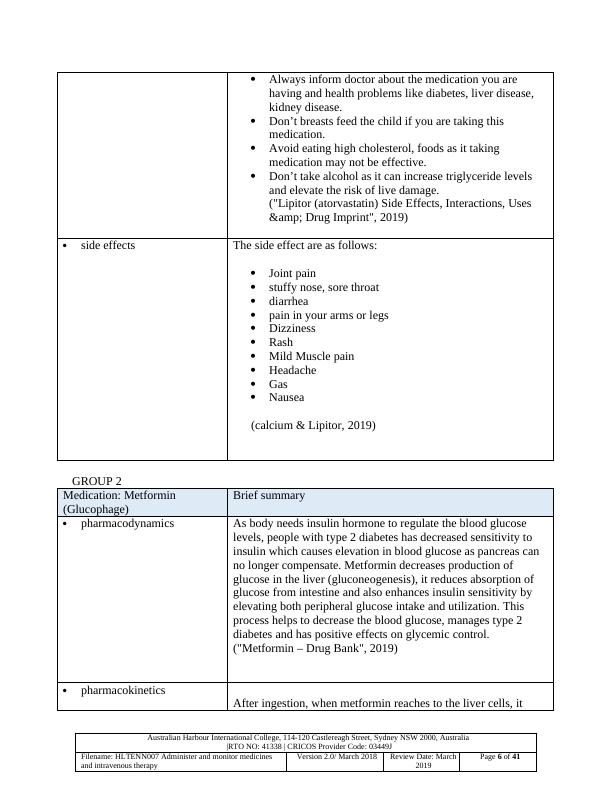
builds up in cells and in the mitochondria where different
mechanisms regulate with the help of enzymes resulting in
gluconeogenesis and increases liver sensitivity to insulin.
Metformin is absorbed well when given with food and the
apparent volume of metformin after one oral dose is 850 mg of
metformin where it binds to plasma proteins and is excreted as
unchanged drugs in the urine and does not go hepatic metabolism
as no any metabolites have been identified in human.
("Metformin - Drug Bank", 2019)
adverse reactions Adverse reactions of Metformin are as follows:
Lactic acidosis which can be seen as being tired, weak,
unusual muscle pain, difficulty in breathing,, unusual
sleepiness, nausea, vomiting, dizziness, stomach pain and
slow or irregular heartbeat.
Hypoglycemia, where symptoms include headache,
weakness, confusion, drowsiness, sweating, irritability,
shaking, extreme hunger and fast heartbeat.
("Metformin Adverse Effects – Drug Bank", 2019)
contraindications &
precautions
Contradictions of Metformin:
Renal impairment with increased serum creatine levels or
abnormal creatinine congestive heart failure.
Increased risk of lactic acidosis which is known as a form
of metabolic acidosis due to insufficient clearance of
lactic acid from the blood.
(Dr. Tomislav Mestrovic, 2019)
Precautions:
Avoid drinking large amount of alcohol on a regular basis
as drinking alcohol elevates the risk of lactic acidosis.
If the lever is not functioning normally then metformin
should not be taken as liver disease increases the risk of
lactic acidosis.
Monitoring kidney function test as metformin should not
be taken if the kidney is functioning poor.
During most major surgeries, metformin should be
stopped temporarily and then should be restarted when
the patient is eating normally again.
If there is infections, injuries or fever, metformin is not
enough to treat the diabetes, so insulin may be required.
Metformin decreases the levels of vitamin B12, so if the
patient has deficiency of vitamin B12, it should be
monitored closely.
Australian Harbour International College, 114-120 Castlereagh Street, Sydney NSW 2000, Australia
|RTO NO: 41338 | CRICOS Provider Code: 03449J
Filename: HLTENN007 Administer and monitor medicines
and intravenous therapy
Version 2.0/ March 2018 Review Date: March
2019
Page 7 of 41
mechanisms regulate with the help of enzymes resulting in
gluconeogenesis and increases liver sensitivity to insulin.
Metformin is absorbed well when given with food and the
apparent volume of metformin after one oral dose is 850 mg of
metformin where it binds to plasma proteins and is excreted as
unchanged drugs in the urine and does not go hepatic metabolism
as no any metabolites have been identified in human.
("Metformin - Drug Bank", 2019)
adverse reactions Adverse reactions of Metformin are as follows:
Lactic acidosis which can be seen as being tired, weak,
unusual muscle pain, difficulty in breathing,, unusual
sleepiness, nausea, vomiting, dizziness, stomach pain and
slow or irregular heartbeat.
Hypoglycemia, where symptoms include headache,
weakness, confusion, drowsiness, sweating, irritability,
shaking, extreme hunger and fast heartbeat.
("Metformin Adverse Effects – Drug Bank", 2019)
contraindications &
precautions
Contradictions of Metformin:
Renal impairment with increased serum creatine levels or
abnormal creatinine congestive heart failure.
Increased risk of lactic acidosis which is known as a form
of metabolic acidosis due to insufficient clearance of
lactic acid from the blood.
(Dr. Tomislav Mestrovic, 2019)
Precautions:
Avoid drinking large amount of alcohol on a regular basis
as drinking alcohol elevates the risk of lactic acidosis.
If the lever is not functioning normally then metformin
should not be taken as liver disease increases the risk of
lactic acidosis.
Monitoring kidney function test as metformin should not
be taken if the kidney is functioning poor.
During most major surgeries, metformin should be
stopped temporarily and then should be restarted when
the patient is eating normally again.
If there is infections, injuries or fever, metformin is not
enough to treat the diabetes, so insulin may be required.
Metformin decreases the levels of vitamin B12, so if the
patient has deficiency of vitamin B12, it should be
monitored closely.
Australian Harbour International College, 114-120 Castlereagh Street, Sydney NSW 2000, Australia
|RTO NO: 41338 | CRICOS Provider Code: 03449J
Filename: HLTENN007 Administer and monitor medicines
and intravenous therapy
Version 2.0/ March 2018 Review Date: March
2019
Page 7 of 41
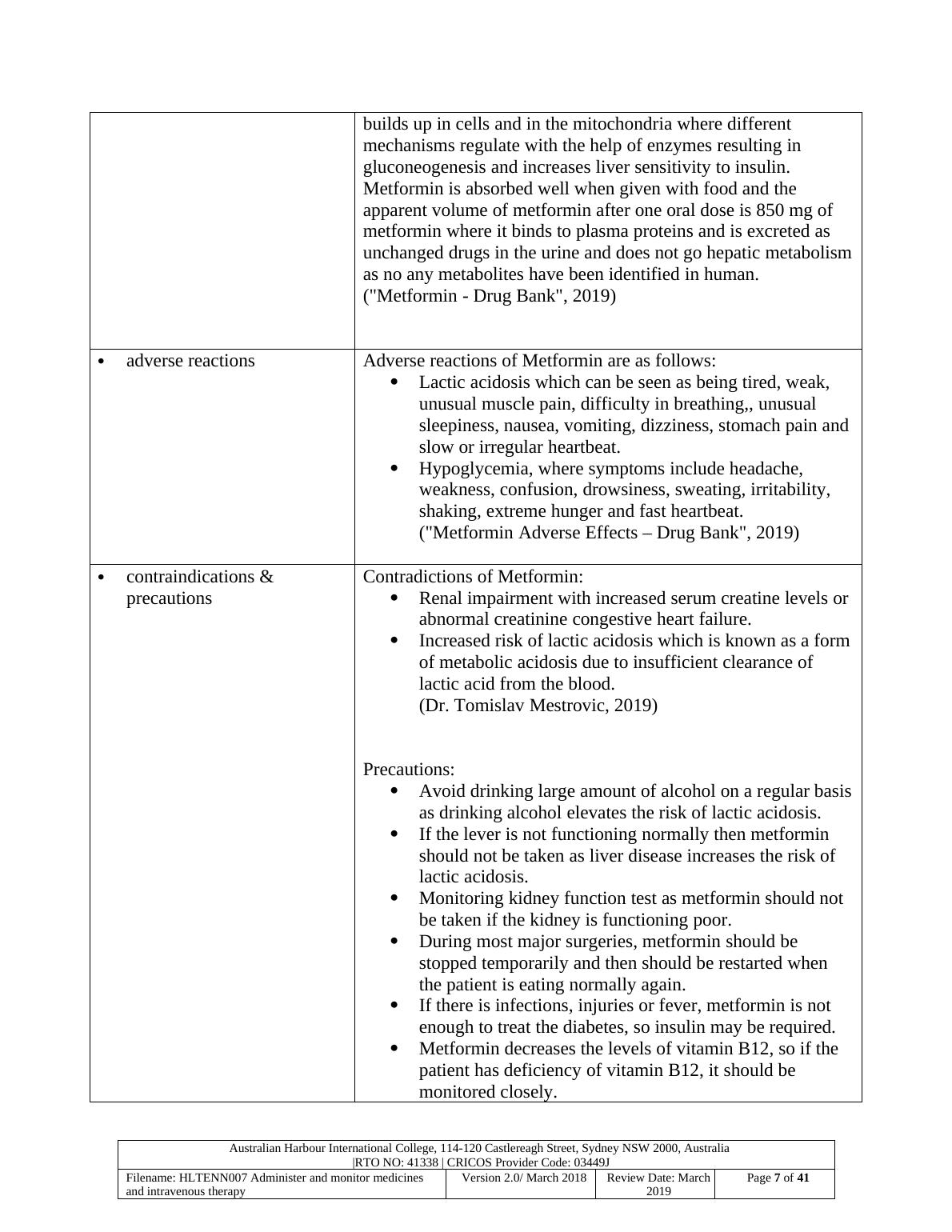
(Clinaero, 2019)
side effects Side effects of metformin are as follows:
physical weakness (asthenia)
diarrhea
gas (flatulence)
low blood sugar (hypoglycemia)
abdominal pain
low blood levels of vitamin B-12
nausea and vomiting
constipation
chest discomfort
("Metformin Side Effects: Common, Severe, Long Term -
Drugs.com", 2019)
Medication: Warfarin
(Coumadin) Brief summary
pharmacodynamics Warfarin is used to prevent and treat thromboembolic disease
which includes venous thrombosis, thromboembolism and
pulmonary embolism and also prevents ischemic strokes in
patients with atrial fibrillation. Warfarin inhibits vitamin K
reductase which helps to reduce the form of vitamin K and as a
result it reduces the thrombogenicity of clots. ("Warfarin - Drug
Bank", 2019)
pharmacokinetics Absorption
It is absorbed rapidly when administered orally and also
absorbed percutaneous, however, it varies from individual.
Warfarin binds to blood plasma proteins and is metabolized in
the liver where warfarin is almost entirely excreted by
metabolism, little amount of warfarin is excreted in the urine and
metabolites are excreted into the bile in lesser amount.
("Warfarin - Drug Bank", 2019)
adverse reactions Skin necrosis or gangrene
Bleeding strokes or brain strokes(Hemorrhagic strokes)
Aortic Valve stenosis or hardening of arteries which means
the calcium accumulates in the arteries and narrows the aortic
valve that goes from heart and carries oxygen to the body.
If the warfarin is used for a long term, the risk of Alzheimer’s
and dementia is increased
Purple toes syndrome where the toes is seen in purple for
dark colors with extreme pain.
("3 Dangerous Warfarin Side Effects Long Term Effects of
Warfarin", 2019)
Australian Harbour International College, 114-120 Castlereagh Street, Sydney NSW 2000, Australia
|RTO NO: 41338 | CRICOS Provider Code: 03449J
Filename: HLTENN007 Administer and monitor medicines
and intravenous therapy
Version 2.0/ March 2018 Review Date: March
2019
Page 8 of 41
side effects Side effects of metformin are as follows:
physical weakness (asthenia)
diarrhea
gas (flatulence)
low blood sugar (hypoglycemia)
abdominal pain
low blood levels of vitamin B-12
nausea and vomiting
constipation
chest discomfort
("Metformin Side Effects: Common, Severe, Long Term -
Drugs.com", 2019)
Medication: Warfarin
(Coumadin) Brief summary
pharmacodynamics Warfarin is used to prevent and treat thromboembolic disease
which includes venous thrombosis, thromboembolism and
pulmonary embolism and also prevents ischemic strokes in
patients with atrial fibrillation. Warfarin inhibits vitamin K
reductase which helps to reduce the form of vitamin K and as a
result it reduces the thrombogenicity of clots. ("Warfarin - Drug
Bank", 2019)
pharmacokinetics Absorption
It is absorbed rapidly when administered orally and also
absorbed percutaneous, however, it varies from individual.
Warfarin binds to blood plasma proteins and is metabolized in
the liver where warfarin is almost entirely excreted by
metabolism, little amount of warfarin is excreted in the urine and
metabolites are excreted into the bile in lesser amount.
("Warfarin - Drug Bank", 2019)
adverse reactions Skin necrosis or gangrene
Bleeding strokes or brain strokes(Hemorrhagic strokes)
Aortic Valve stenosis or hardening of arteries which means
the calcium accumulates in the arteries and narrows the aortic
valve that goes from heart and carries oxygen to the body.
If the warfarin is used for a long term, the risk of Alzheimer’s
and dementia is increased
Purple toes syndrome where the toes is seen in purple for
dark colors with extreme pain.
("3 Dangerous Warfarin Side Effects Long Term Effects of
Warfarin", 2019)
Australian Harbour International College, 114-120 Castlereagh Street, Sydney NSW 2000, Australia
|RTO NO: 41338 | CRICOS Provider Code: 03449J
Filename: HLTENN007 Administer and monitor medicines
and intravenous therapy
Version 2.0/ March 2018 Review Date: March
2019
Page 8 of 41
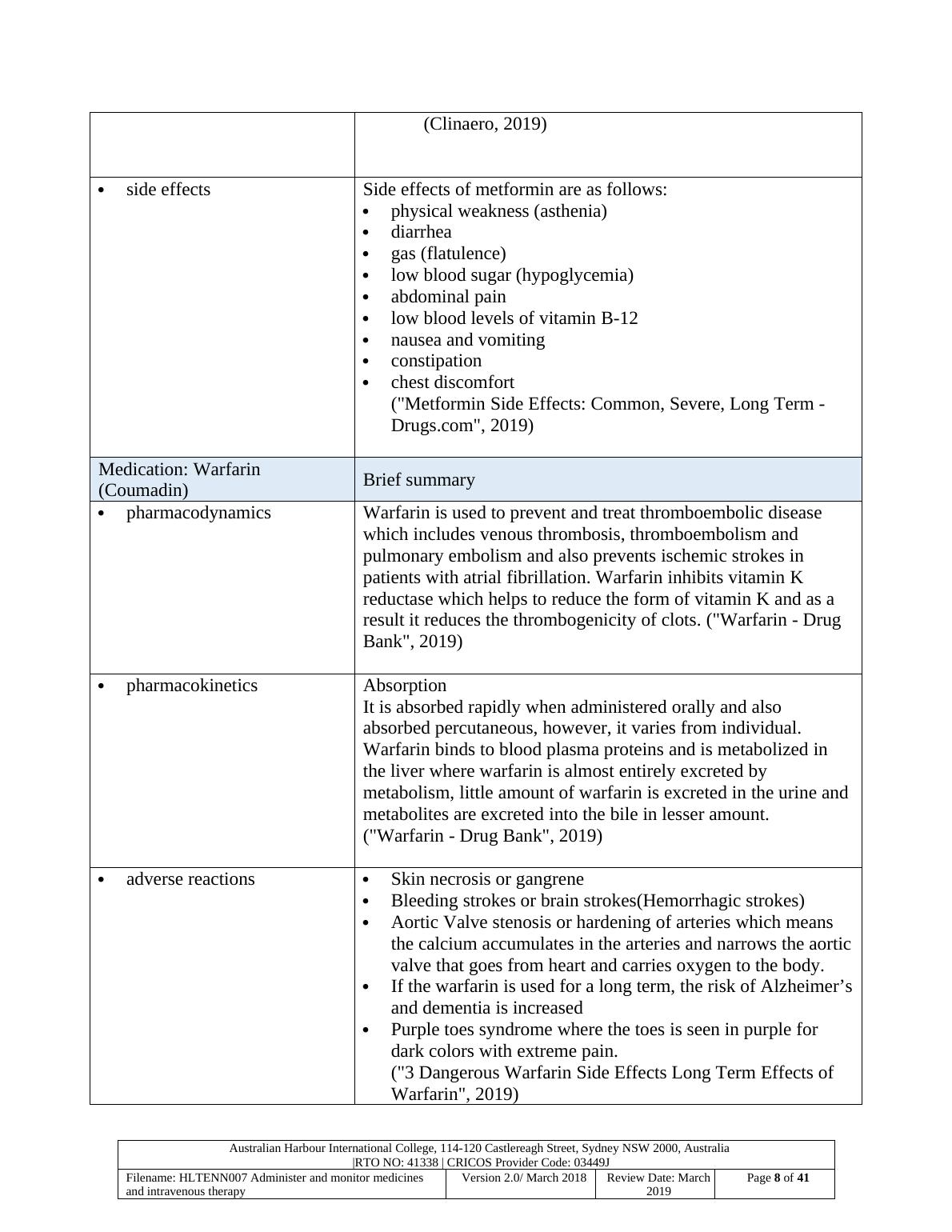
End of preview
Want to access all the pages? Upload your documents or become a member.
